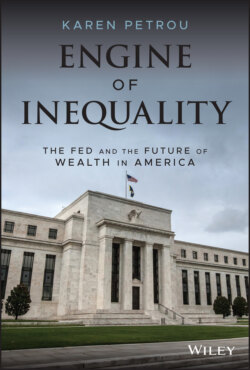Читать книгу Engine of Inequality - Karen Petrou - Страница 12
The Economic-Recovery Mirage
ОглавлениеThe Federal Reserve touted a robust US economy starting in 201526 and then up to and even after COVID hit in March 2020.27 President Trump cited stock prices, gross domestic product (GDP), and “record” employment numbers when it suited him. When it didn't, he blamed the Fed, arguing that big economic gains on all of these counts would have continued were it not for a miserly central bank or, after COVID, unduly cautious public-health officials. Mr. Trump had a far better sense of the electorate's mood and how to move it than the Fed. But each of their statements nonetheless portrayed a prosperity remote from the lives of many, including large percentages of those who voted for Donald Trump in 2016.
The Fed and President Trump make the same mistake: they measure the economy by across-the-board indicators. Most of these matter only to the wealthiest Americans who own most of the assets in the stock and bond market. Unemployment may have looked as if it was at record-breaking lows before the pandemic, but that's only if you ignore labor-participation rates, which also show who wants to work or work more. At the height of the seeming boom in 2019, one-third of Americans reported that they were not working as much as they wanted. This is a far more telling number than the aggregate employment dot on the Fed's chart. It proves just how many Americans struggled. Indeed, even this number underestimates the struggle – far more Americans worked more jobs and/or more hours than ever before in late 2019, but their wages barely budged.28
From 1989 to 2018, middle-class, real (i.e., inflation-adjusted) wealth increased about 1 percent a year;29 over the same period, real gross domestic product went up about 2.5 percent a year.30 Clearly, someone was getting a lot richer as the US economy prospered, but it was not the middle class.
It's not just numbers that obscure the economic reality confronting most Americans. Many economists also firmly believe that capitalism ensures that those who try are those who win. For economists, this conclusion is cloaked in “efficient market” theory – that is, markets reward skill and talent. Conservative politicians concur, but also believe that wealth accumulated ultimately trickles down to lower-income workers, who then get their chance to compete for capitalism's rewards. Some have even said that it's not actually all that bad that almost 40 percent of Americans can't handle a $400 expense since most of them have friends or willing creditors.31 It goes unsaid that such assistance impoverishes families and loads them down with debt in an endless, debilitating cycle of deepening impoverishment.
Some go beyond aggregate data or supply-side theory to say that America is only unequal because a lot of Americans are indolent, sometimes renewing attacks on “welfare queens” to argue that folks would get back to work if government benefits such as disability payments to veterans were curtailed.32 Others quibble with various statistics illustrating income and wealth inequality on grounds that this or that data point ostensibly fails to include one or another additional or different data point such as receipt of food stamps that a particular pundit prefers.33 None of these inequality dissenters notes that, even if one adjusts data points up or down to reflect refinements, trend lines are inexorable: America is clearly unequal no matter how one measures income or wealth and became far more unequal far faster after the financial crisis. After 2008, middle-class wealth collapsed, but the wealth of the top 10 percent grew 19 percent in the following decade,34 resulting in the largest wealth-share increase – 6 percentage points – since the Second World War.35 At the same time, middle-income family wealth was still below its 2008 level, and lower-income families lost 16 percent of their pre-crisis wealth (not much to start with, of course).36
